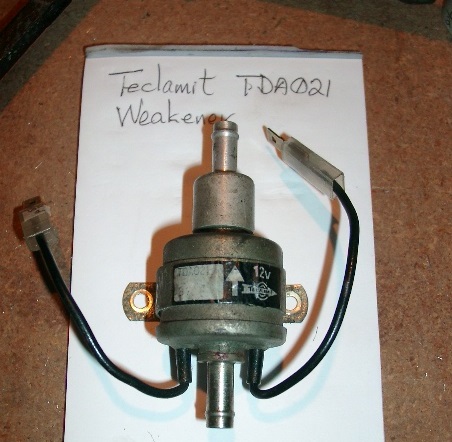| Author | Message | ||
Brian Vogel Grand Master Username: guyslp Post Number: 378 Registered: 6-2009 |
Hello All, Today was a great day at the garage which I feel has brought me much closer to perhaps finding a solution to my idle problems with LRK37110. Since several separate parts of the ignition, EGR, and weakener device are involved, I'm separating things out. Does anyone know what the Teclamit part numbers are for each of these respective solenoids on the series two SY cars? Here is a photo of the weakener solenoid from this car:  The part number printed on the small white square appears to be TDA021. What's peculiar is that the anti-run-on/anti-dieseling solenoid on the car appears to have the same part number. The '0' character is obscured such that it cannot be read, so it's possible that it could be any digit but '0'. Regardless of the part numbers, I definitely have two solenoids that function in precisely the same way: open when not energized and closed when energized. If my understanding is correct it is only the anti-dieseling solenoid that is supposed to behave this way. I thought that the weakener solenoid was its opposite: closed when not energized and open when energized. Can anyone confirm whether my understanding of the above open/closed state description is correct? If it is then someone has definitely put an anti-dieseling solenoid into the car in place of the weakener solenoid at some point. This would definitely make life "interesting" and could potentially explain my idling problem and the things I discovered today when performing the fast-idle set. Brian | ||
Jeff Young Prolific User Username: jeyjey Post Number: 148 Registered: 10-2010 |
Hi Brian, No, both solenoids should be normally-open (closed when energized). The temp switch for the weakener is closed-when-cold*, and so energizes the weakener solenoid when cold. That shuts off the part-vacuum to the float chambers, disabling the weakener until things warm up. When you turn off the ignition, it kills power to the anti-diesel solenoid, which opens and applies full vacuum to the float chambers, weakening the mixture enough to kill the engine. Cheers, Jeff. * Note: some of the other temp switches are closed-when-hot, so that may be where you were remembering a logic inversion. | ||
Brian Vogel Grand Master Username: guyslp Post Number: 382 Registered: 6-2009 |
Jeff, This system is so confusing because they changed "the logic" of the solenoids over the course of production. I finally found where the two solenoids for anti-dieseling and weakener are documented in the parts manual for North American delivery cars with EGR: Chapter B11 - Vapour Emission Control. For my car these are both the same part number for the solenoid, but they're not on earlier cars. It's loads of fun if you're trying to find both of these documented together for the earlier cars, where they're not the same solenoid, because they aren't. You find the information on the anti-dieseling solenoid (which changes part number, but never to my knowledge the behavior of being closed when energized, open when not) in Chapter A13 - Exhaust Gas Recirculation System. The weakener solenoid is still documented in chapter B11, and it changes number over time, sometimes matching the anti-dieseling solenoid number for a given chassis number and sometimes not. Thank you for giving me this information and challenging me to go out and confirm the warning I'd been given regarding these solenoids several years ago, "The configurations of the weakener and anti-dieseling systems changed over the years, so you need to know how the solenoid that you are intending to replace was supposed to work on your car." The easiest route to knowing how they're "supposed to work" is to see if you have the same part number for both specified for your car. Brian | ||
Chris Browne Prolific User Username: chrisb Post Number: 110 Registered: 2-2010 |
Hello Jeff, My understanding has always been that the anti-diesel solenoid is closed when energised and the weakener solenoid is open when energised. Perhaps someone could confirm this or contradict it? Kind regards, Chris | ||
Brian Vogel Grand Master Username: guyslp Post Number: 385 Registered: 6-2009 |
Chris, That had been my understanding, too, but it's clear that this varies based upon chassis number and delivery market. If you check out the chapters in the Illustrated Parts Manual I refer to above, you'll see in Chapter B11, starting on PDF page 4, that the same part number is specified for both the anti-dieseling and weakener solenoids. The same part has to behave in the same way. Since the anti-dieseling solenoid can only work if it allows vacuum to be promptly applied to the carbs when the car is turned off it's got to be open when not energized (which I've confirmed on two cars via direct testing as well). I can attest that on LRK37110 the same solenoid is used for both weakener and anti-dieseling and the behavior is closed when energized, open when not. Brian |